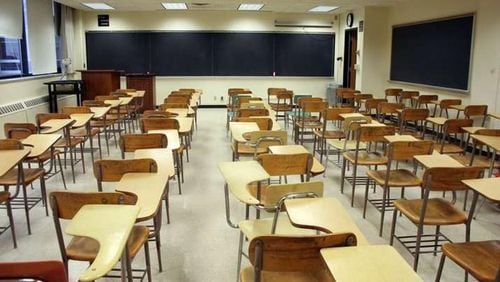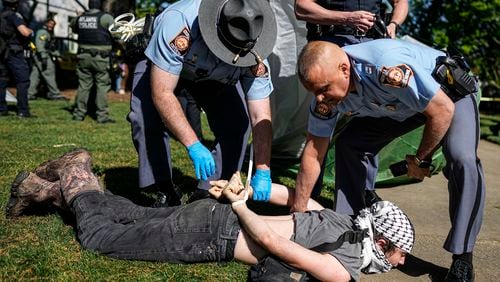New guidance issued Monday for Georgia’s K-12 schools eliminates the coronavirus infection rate in a community as the key consideration when deciding whether or not to bring kids into classrooms.
Now, a revised flow chart that guides superintendents and school boards is premised on schools being open. Shifting the focus from when to open, it advises school leaders instead on when to close.
The initial 10-page guidance document, released June 1 by the Georgia Department of Education, focused on how to react to the local danger level, or "community spread," when making their decisions. The revised document, now 12 pages, focuses more on how to respond to coronavirus cases within school buildings.
There has been immense pressure to open — from parents, President Donald Trump and even pediatricians — who cite detrimental effects of missing school. Parents also need their kids in school so they can return to work. Without schools, the economy suffers.
Many superintendents were unhappy with the original guidance because it focused on a simple measure — the number of local infections — without regard to other facts on the ground, like whether cases were concentrated in assisted living facilities.
Teachers, fearful about their own health or that of family members, have been critical of what they see as a rush to reopen. The Georgia Department of Education’s revisions to its “Path to Recovery for K-12 Schools” document prompted criticism from two big teacher groups, the Professional Association of Georgia Educators and the Georgia Association of Educators.
Lisa Morgan, a kindergarten teacher who has temporarily exited her classroom to serve a term as president of GAE, said she thinks the new guidance will endanger teachers and students by operating as if the default is opening schools regardless of the local spread of the virus.
“We are all going to come into schools as if the school is separate from the community, and that is making us less safe,” she said.
RELATED | Teachers insist their input needed for successful return amid COVID-19
A spokesperson for the state education department said the revision was requested by the Georgia Department of Public Health. It focuses on symptoms, exposure and diagnosis at the school level “to better equip schools to mount a targeted response to exposures or cases within a school community,” Meghan Frick, the agency’s communications director, said in a written statement.
She noted that community spread can still be considered. The new guidance says, for instance, that state and local public health officials may recommend that school districts adopt “more enhanced mitigation strategies” when there are community “flare ups” or “hot spots” of COVID-19.
And school districts, which operate independently in Georgia, have authority not to open and to operate exclusively online, she noted, “and to consider the overall rate of spread in their decision-making.”
Many districts are allowing parents to choose between online or in-person schooling. Last week, Atlanta Public Schools became the first big district to announce it was going online exclusively. Clayton County Public Schools announced the same online only decision Monday evening.
Under the old guidance, schools in communities with low spread could open safely. In areas with “minimal” or “moderate” spread they were to take extra precautions, like allowing each student to attend only every other day to maximize social distancing. Only in areas with “substantial” spread was online education seen as the default.
After the education department released its initial guidance last month, the state public health department tried to define what those spread levels meant; it tied the three levels to the number of cases per 100,000 residents, then created a map based on those categories. The June 7 map shows a plurality of counties in the state were in the middle range and the remainder were either in the danger zone or had insufficient data. None had low or no community spread, meaning none were ready for traditional in-person back to school under the original guidance.
The number of cases statewide has risen since then.
A spokeswoman for the health department last week said the map was a draft, and is no longer being used. She did not respond to an email asking what new criteria were being used to determine the community spread levels.
RELATED | As pressure mounts, Georgia schools figuring out back-to-school plans
ALSO | Another back-to-school COVID-19 challenge: Reeling in kids' bedtimes
The education department’s guidance revision gives more discretion to public health officials to consider nuance in a rapidly evolving situation, said Robert Costley, a former superintendent who now leads a state organization for school administrators.
“What they’ve learned is there’s no playbook for how to handle a pandemic,” he said. School leaders feel obligated to open in part out of worry about child welfare, said Costley, executive director of the Georgia Association of Educational Leaders.
“We’ve got a lot of students who are at home in places of neglect and abuse,” he said. The new guidance gives schools “a path back to the classroom.”
Dr. Carlos del Rio, an infectious diseases expert, said community spread is a crucial measure and also a localized one.
“The challenge we have right now in Georgia, and in many places around the United States, is there’s too much virus in our communities,” said del Rio, executive associate dean of the Emory University School of Medicine and Grady Health System.
In some parts of Georgia, reopening is “a pipe dream,” he said, adding. “I think a lot of rural communities are going to be fine opening. You really need to look at your local epidemiology.”







